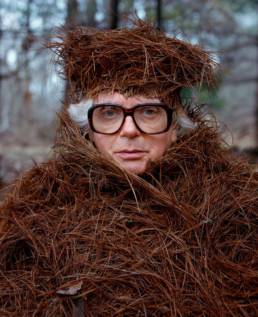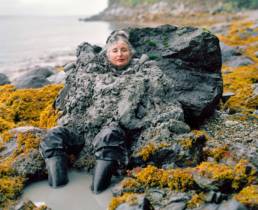Exhibition and Talk Event
initiated and organised by Symbio(s)cene. Curated in collaboration with project partner Culturesphere Gallery.
Exhibition Venue
Culturesphere Gallery, Horemansstr. 30, 80339 Munich
For recordings from the accompanied talk series please scroll down or click here
Exhibition & Talk Event:
Symbio(s)cene presents the exhibition and talk event »People – Nature – Future«. The exhibition shows the internationally awarded works by the Scandinavian artist duo Karoline Hjorth and Riitta Ikonen.
In their remarkable art project »Eyes as Big as Plates«, which has been ongoing since 2011, the artists explore the relationship between people and nature. To this end, they have travelled the world and portrayed people in a wide variety of landscapes. The portrait series shows individuals wrapped in artistic sculptures made from elements of the environment. Nature serves both as content and context here. With playful ease, symbiotic narratives and new aesthetic worlds emerge, conveying a strong message with an aura of stillness: We are nature!
In their continuous search for modern human’s relationship to nature, the artist duo has explored Norway, Finland, France, the USA, Great Britain, Iceland, the Faroe Islands, Sweden, South Korea, the Czech Republic, Japan, Senegal, the Outer Hebrides, Tasmania and Greenland. Within the framework of the exhibition “People – Nature – Future”, the two artists will also visit Munich and its surrounding countryside and carry out a photo shoot here as a further milestone of their art project.
The exhibition was curated in collaboration with project partner Culturesphere and is accompanied by a series of talks with speakers from science, economy and society.
Ausstellung & Vortragsreihe:
Symbio(s)cene präsentiert die Ausstellung und Vortragsreihe »People – Nature – Future«. Die Ausstellung zeigt die international prämierten Arbeiten des skandinavischen Künstlerinnen-Duos Karoline Hjorth and Riitta Ikonen.
In ihrem bemerkenswerten, seit 2011 fortlaufenden Kunstprojekt »Eyes as Big as Plates« erkunden die Künstlerinnen die Beziehung zwischen Mensch und Natur. Dazu haben sie die Welt bereist und Menschen in unterschiedlichsten Landschaften porträtiert. Die Portraitserie zeigt einzelne Personen, gehüllt in kunstvolle Skulpturen aus Elementen der Umgebung. Die Natur dient hier sowohl als Inhalt als auch als Kontext. Mit spielerischer Leichtigkeit entstehen symbiotische Narrative und neue ästhetische Welten, die mit einer Aura der Stille eine starke Botschaft vermitteln: Wir sind Natur!
Auf ihrer kontinuierlichen Suche nach der Zugehörigkeit des modernen Menschen zur Natur hat das Künstlerduo bisher Norwegen, Finnland, Frankreich, USA, Großbrittanien, Island, die Färöer Inseln, Schweden, Südkorea, die Tschechischen Republik, Japan, Senegal, die Äußeren Hebriden, Tasmanien und Grönland bereist. Im Rahmen der Ausstellung »People – Nature – Future« werden die beiden Künstlerinnen auch München und sein Umland besuchen und hier als weiteren Meilenstein ihres Kunstprojekts ein Fotoshooting durchführen.
Die Ausstellung wurde kuratiert in Kollaboration mit Projektpartner Culturesphere und wird begleitet von einer Vortragsreihe mit Sprechern aus Wissenschaft, Wirtschaft und Gesellschaft.
Programme Talk Event / Programm Vortragsreihe (all talks will be held in English)
Sat 23 Oct. 14:00 – 15:00 (CEST)
Live Exhibition Walk-Through & Artist Talk

The artist duo Riitta Ikonen & Karoline Hjorth will give a live tour through the exhibition on ZOOM. They will talk about their on-going art project “Eyes As Big As Plates”, which explores our relationship with our surroundings and aims to reinforce the human connection to the natural world.
Wed 3 Nov. 18:00 – 19:00 (CET)
Wilderness creates multifunctionality: Introducing wildflowers in urban landscapes – An Installation Walk-Through

M. Sc. Sandra Rojas-Botero & M. Sc. Simon Dietzel, both PhD candidates at the Chair of Restoration Ecology, Technische Universität München (TUM) School of Life Sciences, Munich.
Sandra Rojas-Botero and Simon Dietzel will guide through the biodiversity of their installation »Wildflower strip« and will talk about the significance of native wildflower species in urban contexts, their role in urban ecosystems and their contribution to the quality of life and to the human-nature relationship.
Wed 24 Nov. 18:00 – 19:00 (CET)
The Human Insect

Prof. Dr. Mark Wigley, Professor and Dean Emeritus at Columbia University’s Graduate School of Architecture, Planning and Preservation, New York City, United States. Author of various books, e.g. Are We Human?. Co-Founder Volume Magazine. Curator of various exhibitions, e.g. Deconstructivist Architecture at The Museum of Modern Art, New York.
This talk will explore the uncanny fact that humans became insects at the end of the 19th century by sprouting radio antenna that rapidly interconnected all brains and bodies. This radical biological transformation culminated in the production of the single largest human artifact, the ever-expanding global communication system that wraps the planet — weaving itself through the air, underground, underwater, and outer space — yet remaining virtually invisible. The unimaginably vast and dense ecology of antenna took over from buildings to form the architecture of everyday human life. Yet the human has never simply been human. At the very least, the human is a bag of countless different bacteria, the fragile effect of a massive cross-species collaboration. What might be the entanglements between the largely invisible worlds of bacteria and radio? What might be “nature” in this scene?
Fri 3 Dec. 18:00 – 19:00 (CET)
Biodiversity and Wellbeing!

Prof. Dr. Aletta Bonn, Professor and Head of Ecosystem Services, Helmholtz-Centre for Environmental Research – UFZ, Friedrich Schiller University Jena and German Centre for integrative Biodiversity Research (iDiv) Halle-Jena-Leipzig
Biodiversity is closely linked with health and wellbeing. The talk will explain the concept of ecosystem services as nature’s contributions to people. Specifically, the mental health and wellbeing impacts of biodiversity will be highlighted with various current research results. Building on this, links to policy, urban planning and management will be made and a discussion will be initiated on how nature conservation can be understood as a proactive health measure.
Wed 15 Dec. 18:00 – 19:00 (CET)
Dialogue with Nature. The transformative potential of non-instrumental relationships with nature.

Dr. Uta Eser, Biologist & Environmental ethicist,
Büro für Umweltethik, Tübingen
Environmental communication predominantly presents conservation as a matter of human self-interest. In my talk I will argue that this “imperialism of self-interest” (Horkheimer) can be regarded as one root of the current social-ecological crisis. Against a purely instrumental perspective on the human-nature relationship, I propose a relational approach. Using Martin Buber’s philosophy of relationship, I present what characterises this perspective. A stronger consideration of such relational aspects would mean a fundamental shift in societal consciousness. Such a transformation might bring about the profound changes necessary to save both nature and humanity.
Tue 25 Jan. 18:00 – 19:00 (CET)
Otherwise, Ratherwise…Artwise? Speculating a Way Beyond Human-Centered Paradigms in the Green Like a Robot Project.

Dr. Lora Koycheva, Visiting Scholar at the Rachel Carson Center for Environment and Society, Munich.
In this talk, Dr. Koycheva offers an anthropological perspective on the currently dominant human-centered design paradigm, and traces ways in which to dislodge it from its all-too-occidental grounding. She probes ways into which speculative methods and an anthropological approach play out in a nascent global initiative (Green Like a Robot) aimed at imagining, prototyping, and enacting the ways in which (ro)bots can help herald and enact such a paradigm shift. The centrality of the human has long reigned supreme in the explanatory models and creative endeavors that mark our collective experiences of being human, especially in the occidental tradition. What is more, such a tradition often relies on a well-tested heuristic mechanism – dichotomous relations – in order to both construct the world and organize these models of the world: nature-culture, human-animal, human-machine, animate-inanimate. Yet with the advent of the Anthropocene, as well as robotic technology, new heuristics, new methods, new vocabularies, and new responses to worldmaking will become not only necessary, but will also lend themselves to opening up new possibilities for existence.
Hosts / ModeratorInnen

PD Dr. Tina Heger
Co-Founder Symbio(s)cene & Lecturer at Chair of Restoration Ecology, Technische Universität München (TUM), School of Life Sciences, Munich

Ingrid Rügemer
Co-Founder Symbio(s)cene,
Co-Founder Culturesphere GmbH,
& independet Designer, Artist and Curator

Prof. Oliver Szasz
Co-Founder Symbio(s)cene & Professor and Head of Design Management at Macromedia University, Munich
Acknowledgement:
We would also like to thank Frame Contemporary Art Finland for their support, which helped to made this project possible.






